Sori Yanagi Mid Century Japanse Elephant Stool Habitat
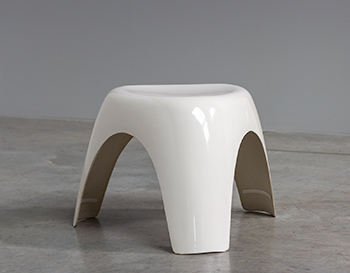
Sori Yanagi Elephant Stool, originally designed in 1954 for Yanagi’s own studio, is an iconic example of post-war Japanese design. This particular version is a limited edition, produced by Habitat in 2001, and crafted from fiberglass, the Elephant Stool is celebrated for its simplicity, functionality, and enduring aesthetic.
Pair of Florence Knoll lounge chairs for Knoll International Circa 1960

A pair of early edition mid-century lounge chairs, designed by Florence Knoll in the 1960s. Featuring a sleek minimalist metal frame, they have been reupholstered in an ivory-coloured fabric by the previous owner. The chairs, geometric design reflects the influence of mid-century modern architecture. Both pieces are in excellent, well-maintained condition.
Ludwig Mies van der Rohe S 533 cane cantilever chair for Thonet

The Ludwig Mies van der Rohe S 533 cane cantilever chair for Thonet is a true icon of modern design, blending elegance with functionality. Designed in the early 20th century by one of the pioneers of modern architecture, this chair features a sleek tubular steel frame that creates a seamless, flowing form. The seat and backrest are crafted from handwoven cane, providing both comfort and a natural aesthetic that contrasts beautifully with the chrome structure. Lightweight yet durable, the chair exemplifies Mies’ philosophy of 'less is more'. Signed with applied foil manufacturer's label to underside: ´Thonet D3558 Frankenberg´.
Christer Norman and Ruud Ekstrand Formula Occasional table 1970

The Formula Occasional Table. A round wooden table featuring a white Formica top with a bold red circular accent, supported by chrome tubular legs.
Designed by Ruud Ekstrand and Christer Norman for the Dux Studio Collection in 1968, Sweden, is an iconic piece from the renowned Formula series. Its minimalist form and modern aesthetic make it a versatile addition to any space, whether used as a side table, coffee table, or decorative accent.
This design perfectly exemplifies Ekstrand and Norman’s ability to seamlessly blend form and function, resulting in a timeless piece that remains highly sought after in contemporary furniture design. The Formula Occasional Table continues to stand out for its elegance, simplicity, and adaptability across various interior spaces.
Alfred Hendrickx Zebrano wood wardrobe with sliding doors for Belform, 1960

Alfred Hendrickx wardrobe for Belform, 1960. Crafted from Zebrano wood, the wardrobe features a striking design with a rectangular black wooden base. It has two sliding doors, behind which are coat hangers on both the left and right sides. The right side includes two shelves, while the left side has one.
Alessandro Pianon modernist orange onion ceiling lamp for Vistosi 1960s

Modernist pendant lamp designed by Alessandro Pianon for Vistosi, Italy, circa 1960. It features an onion-shaped orange glass shade suspended by a steel and electric cable, secured with a black ceiling mount. The lamp radiates a warm, diffused ambient light. Alessandro Pianon was born in Venice, Italy, attended architecture school in Venice and used his talents to become an architect and designer. He was hired by Vetreria Vistosi in 1956 to design the company logo and subsequently created numerous glass collections.
Jules Wabbes rosewood table with geometric chromed base 1970

Table designed by Jules Wabbes, Belgium, 1970s. Featuring a rectangular rosewood veneer top, resting on a geometric, chrome-plated stainless steel base. The base’s visible joints highlight its constructive composition, contributing to its honest and refined design. A timeless addition to any space, perfect as a table or desk.
Pair of sconces by designer and architect Louis Kalff 1959

Pair of sconces designed by Louis Kalff. Circa 1960. They feature a combination of teak wood and white metal. Supporting a cylinder milk glass. Offering a soft light that pleasantly fills the room. Louis Kalff (1897-1976) was a Dutch industrial designer and architect, renowned for his innovative contributions to lighting design. Kalff’s work is characterised by clean lines, innovative use of materials, and a keen attention to detail.
KD27 table lamp designed by Joe Colombo for Kartell in 1967
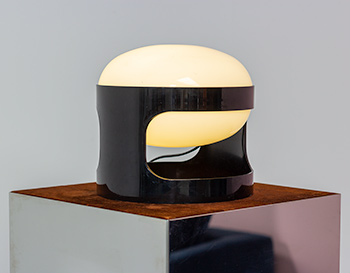
Black KD27 Joe Colombo table lamp. The base is constructed from ABS (Acrylonitrile Butadiene Styrene) plastic, which was a popular material choice during the 1960s and 70s for its durability and versatility. The base supports a double diffuse circular cap. The KD27 serves as both a table lamp and an ambient light, making it a versatile addition to any interior space.
Three seater or sofa design by Erik Worts for Ikea 1962
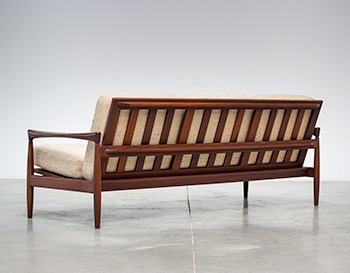
This three-seater sofa, designed by renowned Danish designer Erik Wørts for IKEA, is a timeless piece from the early 1960s. Known as the ‘Kolding’ model, it features a beautifully crafted teak wood frame, highlighting Scandinavian design principles of simplicity and functionality. The off-white wool fabric upholstery adds a layer of understated elegance, perfectly balancing style and comfort. Manufactured by IKEA Sweden circa 1962, the ‘Kolding’ sofa is a rare find, embodying the mid-century modern aesthetic.
Copper pendant light Tallerken by Poul Henningsen for Louis Poulsen 1958
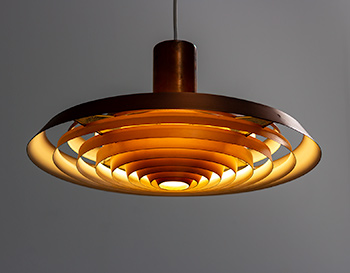
Pendant light designed by Poul Henningsen for Louis Poulsen. Denmark 1958. Hanging lamp Tallerken model formed by concentric rings of copper brass embedded in each other. The light was made for Pavillon Langelinie in Copenhagen in 1958. Poul Henningsen originally trained as an architect at the Copenhagen College of Technology. In 1920, he set up his own architectural office in Copenhagen. He worked as a freelance architect and designed several houses, a factory, a part of the Tivoli amusement park, and the interiors of two theatres. He is considered one of the most influential designers in the field of lighting.
Alfred Hendrickx sideboard with Willy Meysmans ceramic 1958

Large sideboard model nr. 308 designed by Alfred Hendrickx for Belform with sliding door in Unique Ceramic illustration Signed by Willy Meysmans 1958. Sideboard made of Bubinga wood with 4 drawers and two shelves inside.
Set of three plexiglas and Elm wood side tables France 1970
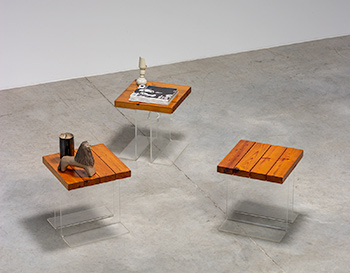
Set of three occasional side tables made of plexiglass and elm wood. France circa 1970. These tables feature a minimalist design that seamlessly blends aesthetics and functionality. The plexiglass base not only supports the tabletop but also elevates the overall design and contribute to the spatial perception.
Set of six mid century wooden chairs with rush seats 1970
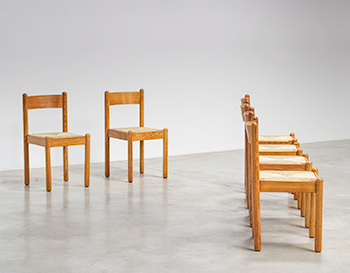
Six mid century dining chairs with hand woven rush seating. France, circa 1970. Solid oak wooden structure with curved plywood backrest made of pressure moulded veneer layers. The chairs have gained a original rich patina through the years. The seats are in very good condition, without any loose cords. Wear consistent with age and use.
Frans Van Praet four postmodern Sevilla chairs for the world expo 92
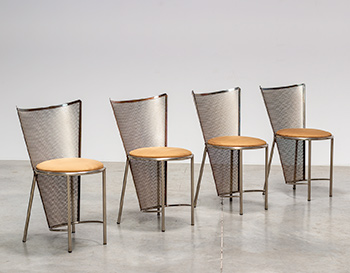
Set of four Sevilla chairs designed by Frans Van Praet for Belgo Chrom, Belgium 1992. The chairs where designed for the Belgian Pavilion in Sevilla Spain '92 world expo. Steel perforated back structure. New upholstered seat in light brown Alcantara suede upholstery. The chairs have gained a natural patina through the years and stand in a good, sturdy condition. Frans Van Praet is a Belgian designer, artist and interior decorator who is still active today. His furniture designs are closely related to the spaces he decorates. He is specialised in (re)installations and renovations of private homes and commercial buildings. One of his most famous interior projects would be The Belgian Pavilion at the Sevilla World Expo.
Friso Kramer Reform Octagon table for Ahrend de Cirkel 1955
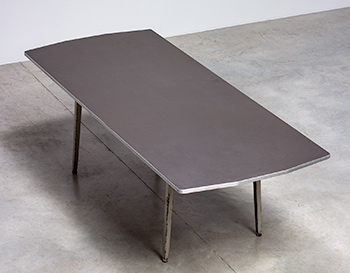
Industrial table designed by Friso Kramer for Ahrend de Cirkel. The Netherlands, circa 1955. This table is the largest version made, 95 inch. Finished with black linoleum and aluminum edge. Industrial grey frame. Kramer’s designs have been exhibited in the Stedelijk Museum in Amsterdam and the Museum Boijmans Van Beuningen in Rotterdam. He is also the recipient of the title 'Royal Designer for Industry' by the Royal Society of Arts in London.